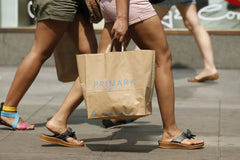
Declining Retail Footfall: Insights into July 2025 Trends and Implications for the UK Retail Sector
Table of Contents
- Key Highlights:
- Introduction
- A Closer Look at Footfall Trends
- The Economic Backdrop
- Shifting Preferences: The Rise of Retail Parks
- Regional Variations and Their Implications
- The Role of Government and Policy Change
- Consumer Confidence and Its Impact on Retail
- The Future of Retail: Strategies for Success
- Conclusion
Key Highlights:
- Total UK footfall decreased by 0.4% year on year from July 6 to August 2, with significant declines in high streets and shopping centres.
- Retail parks experienced a 1.7% increase in footfall, indicating a shift in consumer preferences towards these shopping destinations.
- Consumer confidence continues to decline amid economic challenges, affecting retail performance and expectations.
Introduction
The retail landscape in the UK is undergoing a significant transformation, marked by fluctuating consumer behaviors and economic uncertainties. Recent data from the British Retail Consortium (BRC) highlights a worrying trend: footfall across the nation’s shopping venues has fallen for two consecutive years during the month of July. With high streets and shopping centres witnessing a decline in shopper numbers, the implications for retailers are profound. While some areas, particularly retail parks, show resilience, the need for strategic adaptations is evident. This article delves into the latest statistics, analyzes the underlying factors contributing to these trends, and discusses potential strategies for revitalizing the retail sector.
A Closer Look at Footfall Trends
The BRC's latest report reveals that total footfall in the UK fell by 0.4% year on year from July 6 to August 2, improving slightly from a decline of 1.8% in June. This data underscores a persistent trend, with high street footfall dropping by 1.7% and shopping centre visits declining by 0.3%. In stark contrast, retail parks emerged as a beacon of hope, recording a year-on-year increase of 1.7%, a significant rebound from the previous month’s decline of 1.1%.
The regional breakdown of footfall trends presents a mixed picture. Wales experienced a modest uptick of 0.4%, while England saw a decrease of 0.3%, Scotland faced a 1.3% dip, and Northern Ireland reported the most significant decline at 3%. These statistics highlight the varied consumer experiences across different regions and suggest that while some areas are adapting well, others are struggling under the weight of economic pressures.
The Economic Backdrop
The decline in retail footfall cannot be fully understood without considering the broader economic context. The UK economy has faced challenges, including inflationary pressures that have shaken consumer confidence. In July, consumer expectations regarding the economy's performance over the next three months worsened, dropping to -33, compared to -28 in June. This decline in consumer sentiment is a critical factor influencing shopping behaviors, as individuals become more cautious with their spending in uncertain times.
Retailers are feeling the impact of these economic conditions. Helen Dickinson, CEO of the BRC, emphasized that July’s performance did not bring the anticipated summer boost in shopper numbers. Instead, it was a month marked by continued declines, which could have lasting implications for retailers' recovery and growth prospects.
Shifting Preferences: The Rise of Retail Parks
The notable increase in footfall at retail parks raises questions about changing consumer preferences. Unlike traditional shopping centres, retail parks offer a different shopping experience that seems to resonate with consumers. These venues often feature larger store formats, ample parking, and a variety of shopping options, making them attractive destinations for families and shoppers looking for convenience.
Prominent brands are recognizing this shift, with some opening new outlets in retail parks, further driving foot traffic. This trend suggests that retailers may need to rethink their strategies and consider investing in retail park locations to capture this growing consumer base. The performance of retail parks could serve as a model for revitalizing other shopping formats by offering a more appealing shopping experience.
Regional Variations and Their Implications
The regional variations in footfall underscore the need for localized strategies within the retail sector. While Wales recorded a slight increase, the declines in England, Scotland, and Northern Ireland signal different challenges that retailers must navigate. Urban centres like Manchester, Birmingham, and Leeds have shown improvements in store visits, indicating that strategic investments in these areas might yield better results.
Retailers in declining regions may need to reassess their marketing strategies, enhance the shopping experience, and collaborate with local governments to create more inviting environments. Initiatives that focus on community engagement, events, and improved infrastructure can help drive footfall in these areas.
The Role of Government and Policy Change
The BRC has called for significant reforms to support the retail sector, particularly in light of the challenges posed by empty shop fronts and declining footfall. The government’s plan to reduce business rates for retail, hospitality, and leisure premises is seen as a positive step, but many stakeholders argue that more substantial cuts are essential to revitalize town and city centres effectively.
With around one in seven shops currently lying empty, the urgency for action is palpable. Retailers depend on larger anchor stores to attract footfall; thus, any reforms must ensure that no store bears an excessive financial burden. A balanced approach in policy-making can help nurture the retail landscape, ensuring that it adapts to changing consumer needs while supporting local economies.
Consumer Confidence and Its Impact on Retail
As inflation continues to shake consumer confidence, the ripple effects are felt throughout the retail sector. The diminishing expectations regarding the economy can lead to reduced spending, which, in turn, impacts retailers' bottom lines. A cautious consumer base may prioritize essential purchases over discretionary spending, further exacerbating the challenges faced by retailers.
To combat this trend, retailers may need to innovate in how they engage with customers. Offering personalized experiences, loyalty programs, and targeted promotions can help attract footfall. Additionally, leveraging digital channels to reach consumers where they are spending their time can enhance visibility and drive traffic to physical stores.
The Future of Retail: Strategies for Success
In light of the current trends and challenges, retailers must adopt a proactive approach to ensure their sustainability and growth. Here are several strategies that could enhance footfall and improve overall performance:
Embracing Omnichannel Retailing
Retailers should focus on integrating online and offline experiences, allowing customers to shop seamlessly across multiple channels. This could mean enhancing e-commerce platforms, offering click-and-collect options, or ensuring that in-store experiences are complemented by robust online marketing efforts.
Enhancing the In-store Experience
Creating an inviting and engaging in-store environment is critical. Retailers could implement experiential shopping opportunities, such as product demonstrations, workshops, or events that encourage customers to visit stores. A unique shopping experience can differentiate a retailer from competitors and attract foot traffic.
Investing in Technology
Utilizing technology to enhance customer interactions can be beneficial. From mobile apps that provide personalized recommendations to in-store kiosks that offer assistance, technology can streamline the shopping process and make it more enjoyable for consumers.
Collaborating with Local Communities
Engagement with local communities can foster loyalty and drive footfall. Retailers should consider partnerships with local organizations, schools, and events to create initiatives that resonate with the community and draw shoppers into their stores.
Focusing on Sustainability
As consumers become more environmentally conscious, retailers should prioritize sustainable practices. This includes sourcing products responsibly, reducing waste, and promoting eco-friendly options. Communicating these efforts can resonate with consumers and enhance brand loyalty.
Conclusion
The current decline in retail footfall highlights the complexities and challenges facing the UK retail sector. While economic pressures and shifting consumer preferences pose significant obstacles, there are also opportunities for innovation and growth. By understanding the underlying factors driving these trends and implementing strategic initiatives, retailers can adapt to the changing landscape and work towards revitalizing their businesses. The path forward may be challenging, but with a commitment to understanding consumer needs and fostering vibrant shopping environments, the retail sector can emerge stronger and more resilient.
FAQ
What caused the decline in retail footfall in July 2025?
The decline in retail footfall can be attributed to various factors, including economic uncertainties, rising inflation, and changing consumer preferences. Many shoppers are becoming more cautious with their spending, affecting overall foot traffic in retail spaces.
Are retail parks outperforming traditional shopping centres?
Yes, retail parks have shown a year-on-year increase in footfall, while traditional shopping centres have experienced declines. This trend suggests a shift in consumer preferences towards the convenience and variety offered by retail parks.
How can retailers improve footfall in declining regions?
Retailers can enhance footfall by engaging with local communities, improving the in-store experience, and leveraging technology to attract customers. Tailored marketing strategies that resonate with the local population can also drive traffic.
What role does government policy play in supporting the retail sector?
Government policies, such as business rate reductions, can significantly impact the retail sector. However, many stakeholders believe that more substantial reforms are necessary to revitalize town and city centres and reduce the number of empty shops.
How important is consumer confidence for retail performance?
Consumer confidence plays a crucial role in retail performance. When consumers feel uncertain about the economy, they tend to spend less, which directly impacts footfall and sales for retailers.
Povećajte svoju e-trgovinu s našim nedeljnim uvidima i ažuriranjima!
Ostanite u skladu sa onim što se dešava u svijetu trgovine
Adresa e-pošte
Odabrano za Vas


07 August 2025 / Blog
Block's Bold Vision: Revolutionizing Financial Management for the Future
Pročitajte više
07 August 2025 / Blog


